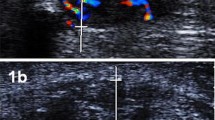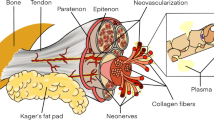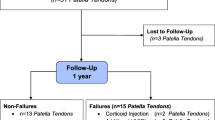Abstract
Sclerosing injections targeting neovascularisation have been demonstrated to give promising clinical results in patients with chronic painful Achilles tendinosis. In this study, fifteen elite or recreational athletes (12 men and three women) with the diagnosis patellar tendinosis/Jumper’s knee in 15 patellar tendons were included. All the patients had a long duration of pain symptoms (mean = 23 months) from the patellar tendon, and ultra-sonography + colour doppler examination showed structural tendon changes with hypo-echoic areas and a neovascularisation, corresponding to the painful area. The patients were treated with ultrasound and colour doppler-guided injections of the sclerosing substance Polidocanol, targeting the area with neovascularisation. At follow-up (mean = 6 months) after a mean amount of three treatments, there was a good clinical result in 12/15 tendons. The patients were back to their previous (before injury) sport activity level, and the amount of pain recorded on a VAS-scale had decreased significantly (VAS from 81 to 10). Our findings indicate that treatment with sclerosing injections, targeting the area with neovessels in patellar tendinosis, has the potential to cure the pain in the tendons and also allow the patients to go back to full patellar-tendon loading activity.



Similar content being viewed by others
References
Alfredson H, Forsgren S, Thorsen K, Lorentzon R (2001) In vivo microdialysis and immuno-histochemical analyses of tendon tissue demonstrated high amounts of free glutamate and glutamate NMDAR1 receptors, but no signs of inflammation, in Jumper’s knee. J Orthop Res 19:881–886
Alfredson H, Forsgren S, Thorsen K, Fahlström M, Johansson H, Lorentzon R (2001) Glutamate NMDAR1 receptors localised to nerves in human Achilles tendons. Implications for treatment? Knee Surg Sports Traumatol Arthrosc 9:123–126
Coleman BD, Khan KM, Maffulli N, Cook JL, Wark JD (2000) Studies of surgical outcome after patellar tendinopathy: clinical significance of methodological deficiencies and guidelines for future studies. Scand J Med Sci Sports 10:2–11
Coleman BD, Khan KM, Kiss ZS, Bartlett J, Young DA, Wark JD (2000) Open and arthroscopic patellar tenotomy for chronic patellar tendinopathy. a retrospective outcome study. Am J Sports Med 28(2):183–190
Conrad P, Malouf GM, Stacey MC (1995) The Australian polidocanol (aethoxysklerol) study. Results at 2 years. Dermatol Surg 21(4):334–336
Cook JL, Khan KM, Harcourt PR, Grant M, Young DA, Bonar SF (1997) A cross sectional study of 100 athletes with jumper’s knee managed conservatively and surgically. Br J Sports Med 31:332–336
Cook JL (2001) What’s the appropriate treatment for patellar tendinopathy? Br J Sports Med 35(5):291–294
Dickenson AH, Chapman V, Green GM (1997) The pharmacology of excitatory and inhibitory amino acid-mediated events in the transmission and modulation of pain in the spinal cord. A review. Gen Pharmacol 28(5):633–638
Guex JJ (1993) Indications for the sclerosing agent polidocanol. J Dermatol Surg Oncol 19(10):959–961
Johnson DP (1998) Arthroscopic surgery for patellar tendonitis. Arthroscopy 14(Suppl 1):44
Karlsson J, Lundin O, Wigerstad Lossing I, Peterson L (1991) Partial rupture of the patellar ligament. Results after operative treatment. Am J Sports Med 19(4):403–408
Karlsson J, Kälebo P, Goksör L-Å, Thomee R, Swärd L (1992) Partial rupture of the patellar ligament. Am J Sports Med 20(4):390–395
Kettunen JA, Kvist M, Alanen E, Kujala UM (2002) Long-term prognosis for Jumper’s knee in male athletes. A prospective follow-up study. Am J Sports Med 30(5):689–692
Khan KM, Cook JL, Kiss ZS, Visentini PJ, Fehrmann MW, Harcourt PR, Tress BW, Wark JD (1997) Patellar tendon ultrasonography and Jumper’s knee in female basketball players: a longitudinal study. Clin J Sports Med 7:199–206
Khan KM, Maffuli N, Coleman BD, Cook JL, Taunton JE (1998) Patellar tendinopathy: some aspects of basic science and clinical management. Br J Sports Med 32:346–355
Khan KM, Visentini PJ, Kiss ZS, Desmond PM, Coleman BD, Cook JL, Tress BM, Wark JD, Forster BB (1999) Correlation of ultrasound and magnetic resonance imaging with clinical outcome after patellar tenotomy: prospective and retrospective studies. Clin J Sports Med 9:129–137
Khan KM, Cook JL, Maffuli N, Kannus P (2000) Where is the pain coming from in tendinopathy? It may be biochemical, not only structural, in origin. Br J Sports Med 34(2):81–83
Lian Ö, Holen KJ, Engebretsen L, Bahr R (1996) Relationship between symptoms of Jumper’s knee and the ultrasound characteristics of the patellar tendon among high level male volleyball players. Scand J Med Sci Sports 6:291–296
Raatikainen T, Karpakka J, Puranen J, Orava S (1994) Operative treatment of partial rupture of the patellar ligament. Int J Sports Med 15:46–49
Saillant G, Rolland E, Garcon P, Melchior B, Benacet JP, Roy-Camille R (1991) Surgical treatment of patellar tendinitis. A series of 80 cases. J Traumatol Sport 8:114–120
Terslev L (2001) Ultrasound and Power Doppler findings in Jumper’s knee-preliminary observations. Eur J Ultrasound 13(3):183–189
Testa V, Capasso G, Maffulli N, Bifulco G (1998) Ultrasound-guided percutaneous longitudinal tenotomy for the management of patellar tendinopathy. Med Sci Sports Exerc 31(11):1509–1515
Weinberg EP, Adams MJ, Hollenberg GM (1998) Color doppler sonography of patellar tendinosis. AJR Am J Roentgenol 171(3):743–744
Öhberg L, Lorentzon R, Alfredson H (2001) Neovascularisation in Achilles tendons with painful tendinosis but not in normal tendons: an ultrasonographic investigation. Knee Surg Sports Traumatol Arthrosc 9:233–238
Öhberg L, Alfredson H (2002) Ultrasound guided sclerosis of neovessels in painful chronic Achilles tendinosis: pilot study of a new treatment. Br J Sports Med 36:173–177
Acknowledgement
Funding for the study has been achieved through the Swedish Research Council for Sports.
Author information
Authors and Affiliations
Corresponding author
Rights and permissions
About this article
Cite this article
Alfredson, H., Öhberg, L. Neovascularisation in chronic painful patellar tendinosis—promising results after sclerosing neovessels outside the tendon challenge the need for surgery. Knee Surg Sports Traumatol Arthrosc 13, 74–80 (2005). https://doi.org/10.1007/s00167-004-0549-x
Received:
Accepted:
Published:
Issue Date:
DOI: https://doi.org/10.1007/s00167-004-0549-x




